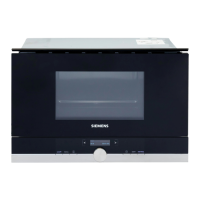en How it works
26
¡ Do not add salt until after the food has been grilled.
Salt draws water from the meat.
¡ Dark meat, such as beef, browns more quickly than lighter-coloured meat, such as veal or pork. When grilling
light-coloured meat or fish, these often only brown slightly on the surface, although they are cooked and juicy on
the inside.
¡ The grill element switches on and off continuously. This is normal. The grill setting that you use determines how
frequently this occurs.
¡ Smoke may be produced when grilling.
Food Amount Weight Grill setting Cooking time
Neck steaks, approx.
2 cm thick
3-4pieces Approx. 120 g each 3 (high) 1st side: Approx. 15
mins
2nd side: Approx.
10-15 mins
Grilled sausages 4-6pieces Approx. 150 g each 3 (high) 1st side: Approx.
10-15 mins
2nd side: Approx.
10-15 mins
Fish steak
1
2-3pieces Approx. 150 g each 3 (high) 1st side: Approx. 10
mins
2nd side: Approx.
10-15 mins
Fish, whole, e.g.
trout
1
2-3pieces Approx. 150 g each 3 (high) 1st side: Approx. 15
mins
2nd side: Approx.
15-20 mins
Toast (pretoast) 2-6slices 3 (high) 1st side: Approx. 4
mins
2nd side: Approx. 4
mins
Toast with topping 2-6slices 3 (high) Depending on top-
ping: 5-10 mins
1
Grease the wire rack with oil beforehand.
18.6 Combining the grill and microwave
To reduce the cooking time, you can use the grill in combination with the microwave.
Combining the grill and microwave
Note:
Cooking tips
¡ Place the cookware onto the wire rack.
¡ Defrost frozen food beforehand.
¡ For roasting, use a deep dish. If you cover the cookware when you cook your food, this will keep the cooking
compartment cleaner.
¡ Arrange chicken, chicken portions and duck breast skin side up.
¡ For bakes and gratins, use large, flat cookware.
Food takes longer to cook in narrow, deep cookware and browns more on top.
¡ Leave bakes and gratins to stand for 5minutes in the appliance after it has been switched off.
¡ Check whether the cookware fits in the cooking compartment. The cookware should not be too big.
¡ Leave the meat to sit for 5-10minutes before carving.
This allows the meat juices to be distributed evenly so that they do not run out when the meat is carved.

